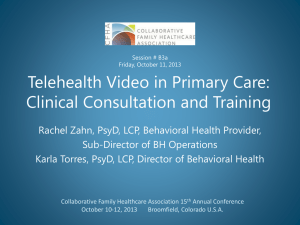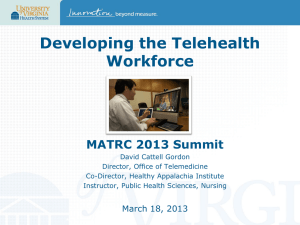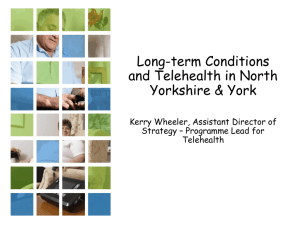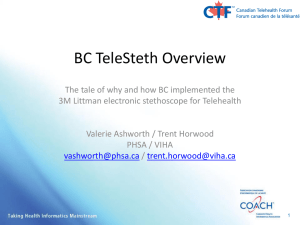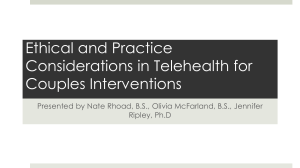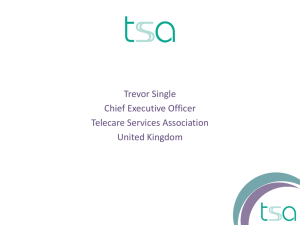Title of Presentation - Collaborative Family Healthcare Association
advertisement
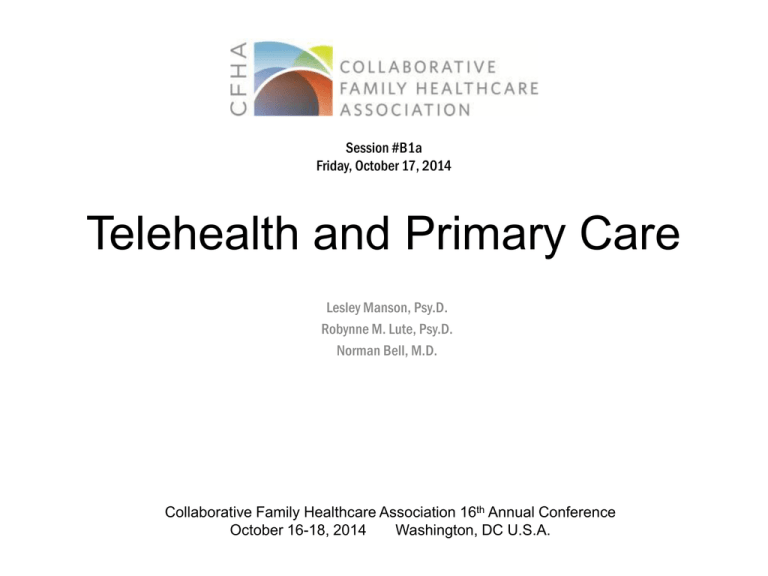
Session #B1a Friday, October 17, 2014 Telehealth and Primary Care Lesley Manson, Psy.D. Robynne M. Lute, Psy.D. Norman Bell, M.D. Collaborative Family Healthcare Association 16th Annual Conference October 16-18, 2014 Washington, DC U.S.A. Faculty Disclosure We have not had any relevant financial relationships during the past 12 months. Learning Objectives At the conclusion of this session, the participant will be able to: Learning Objective #1 Identify, define, and discuss multiple forms of telehealth service provision. Learning Objective #2 List at least 3 empirically supported uses of telehealth for behavioral health care needs. Learning Objective #3 Identify at least 3 benefits of using telehealth technology to assist Triple Aims objectives. References 1. American Psychological Association (2013). American Psychological Association Joint Task Force on the Development of Telepsychology Guidelines for Psychologists. Retrieved from https://www.apapracticecentral.org/ceguidelinestelepsychologyguidelines.pdf 2. American Telemedicine Association State Medicaid Best Practice telemental and behavioral health (2013). Retrieved from americantelemed.org 3. Anthony, K., Merz Nagel, D., & Goss, S. (Eds). (2010). The use of technology in mental health: Applications, ethics, and practice. Springfield, IL: Charles C. Thomas Publisher, LTD. 4. Brady, C. (2013). The role of telehealth in an integrated health delivery system: How telehealth can provide the bridge between patients and health care providers. Managed Care Outlook, 26(15): 1 5. Committee on National Security Systems (2010). National information assurance (IA) glossary. Retrieved from https://www.cnss.gov/assets/pdf/cnssi_4009.pdf 6. Copeland, J. & Martin, G. (2004). Web-based interventions for substance use disorders: A qualitative review. Journal of Substance Abuse Treatment, 26(2), 109-116. 7. Dahl, D. (2014). People, technology, and process meet the triple aim. Nursing Administration Quarterly, 38(1):13. 8. Frueh, B., Henderson, S., & Myri, H. (2005). Telehealth service delivery for persons with alcoholism. Journal of Telemedicine and Telecare, 11, 372-375. 9. Godleski, L., Darkins, A., & Peters, J. (2012). Outcomes of 98,609 U.S. Department of Veterans Affairs patients enrolled in telemental health services, 2006–2010. Psychiatric Services, 63(4), 383-385. doi:10.1176/appi.ps.201100206 10. Institute of Medicine (1996). Assessing medical technologies. Washington, D.C: National Academy Press. 11. LeRouge, C. & Garfield, M. J. (2013). Crossing the telemedicine chasm: Have the US barriers to widespread barriers to widespread adoption of telemedicine been significantly reduced? International Journal of Environmental Journal of Environmental Responsibility and Public Health, 10(2): 6472-6484. 12. Maheu, M., Whitten, P., & Allen, A. (2001). E-heath, telehealth, and telemedicine: A guide to startup and success. San Francisco, CA: Jossey Bass Publishing. 13. Myers, K. & Turvey, C. (2012). Telemental health: Clinical, technical, and administrative foundations of evidence-based practice. Waltham, MA: Elsevier Inc. 14. Nelson, E., & Bui, T. (2010). Rural telepsychology services for children and adolescents. Journal of Clinical Journal of Clinical Psychology: In Session. 66(5):490-501. 15. Nelson, E.-L., Davis, K.C., Sharp, S., & Borror, H. (2007). An integrated telehealth intervention for youth intervention for youth depression. Telemedicine and e-Health, 13(2), 193. 16. Nelson, E.-L., Ellerbeck, K., & Davis, K. C. (2008). Team-based approaches in pediatric telemental health. Learning Assessment • A learning assessment is required for CE credit. • A question and answer period will be conducted at the end of this presentation. Telehealth and Primary Care • • • • What is Telehealth? Empirical support Uses within primary care setting Integrated care and collaboration – Providers – Community organizations – Stakeholders • Triple Aim objectives • Case Examples • Questions and Discussion Definitions & Terms • Telemedicine: the use of electronic information and communications technologies to provide and support health care when distance separates the participants. (Institute of Medicine, 1996) • Tele-Behavioral Health (TBH): the provision of psychological and behavioral medicine services using telecommunication technologies. Communications Technologies • • • • • • • • • • Email Chat and Instant Messaging (SMS) Telephone Cellular phones and Texting Social Networks Websites and Blogs Videoteleconferencing (VTC) Virtual Reality Computer-Aided Therapy Health Information Technology Why Utilize Telehealth? • Provider Distribution • Capitated Health Care Services/Lower Costs* • Growing Population Health Concerns • Patients with Limited Access to Care • Provider Support Distance/Time/Travel • Patients and Families • Outreach Physician • Isolation of Providers • Patient Preference • National/International Travel and Needs • Cultural Considerations (e.g., use asynchronous communication to overcome language barriers) Quick Stats • 74% of teleconsults led to a change in diagnosis or treatment • 60% of telehealth cases solved without a faceto-face visit • 75% of U.S. Consumers say they would use telehealth • 30% of smartphone users are likely to use wellness apps by 2015 • 500 mobile health projects worldwide Telehealth Applications 1. Tele Consultation • 2. Tele Monitoring • 3. CMEs, CEUs Tele Mentoring • 5. Direct and Indirect Monitoring Tele Education / Learning • 4. Direct and Indirect Care Direct Consultation and Professional Development Tele Conferencing • Case, Staff, and Professional Conferencing Our Focus—Patient Care Applications Photo Credit: Splashmarcomms.com Tele-behavioral Health (TBH) in Primary Care • • • Mental health, substance abuse, lifestyle and health behaviors, psychosocial concerns Research on VTC—mental health including psychiatry Satisfaction research – Patients, their families, and clinicians endorse high levels of satisfaction with TMH • Comparability between TBH and same-room care – “Studies have demonstrated equivalence between same-room care and TMH care in psychiatric diagnosis, psychological assessment, treatment plan development, and treatment outcomes for both psychiatry and psychotherapy” (Turvey & Myers, p. 397) – Research includes large RCT • Effectiveness Research – Supported by large RCTs – Growing literature supporting asynchronous CBT over the internet • Future Directions – “need research into the growing availability of technologic adjuncts to therapy such as webbased programs to support intersession behavioral practice or relaxation” – Areas for improvement, despite literature supporting clinical and research effectiveness Empirical Support • Overwhelmingly positive for TMH • No contraindications for use of VTC in MH care • Comparability – Children – Adults – Geriatrics – Cognitively impaired Photo Credit: Takomabibelot Empirical Support • Mental Health Disorders – Mood disorders – Anxiety disorders – Substance-use disorders – Psychotic disorders • Treatment Settings – Outpatient – Inpatient – Institutionalized – Correctional settings WHO and • Primary Care Providers • Behavioral Health Providers • Specialty Medical Care • Specialty Mental Health Care • Medical Team Professionals • School Personnel • Social Support Network • • • • • • • • • • • WHAT? Community Support/Services Individual Direct Service Medical Care Behavioral / Lifestyle Medicine Behavioral Health Services Specialty Care Population Health Self Management Outcomes / Monitoring Mentoring Learning TRIPLE AIM • Improved patient care and satisfaction • Early identification and intervention w Specialty • Holistic approach/collaborative/pt centered • Improved compliance with medical treatment • Improved outreach and communication • Improved inclusion of support system and community • Ease and familiarity with service • Improvement of population health; reduced health disparities; consultation; education; mentoring; increased compliance • Improved cost containment; targeted use of resources; revenue generation; reduced hospitalizations; reduced non-compliance leading to additional costs; reduced ED visits Telehealth Consultation Indirect and Direct Care Photo Credit: averaphoto42012 Photo Credit: ODCHC, 2009 Telehealth Monitoring Telehealth Education / Learning Telehealth Mentoring Telehealth Conferencing Core Guidelines • Competence of Provider • Standards of Care in Delivery • Informed Consent • Confidentiality of Data and Information • Security and Transmission of Data and Information • Disposal of Data and Information and Technologies • Testing and Assessment • Interjurisdictional Practice A.P.A., 2013 Core Guidelines • Competence of Provider • Competence in technology and impact of technology on pts and other professionals • Standards of Care in Delivery • Ensure ethical and professional standards of care and practice • Informed Consent • Obtain informed consent to address telehealth services and be cognizant of applicable laws and regulations • Confidentiality of Data and Information • Protect and maintain confidentiality of data and information A.P.A., 2013 Core Guidelines • Security and Transmission of Data and Information • Ensure security measures are in place to protect data/information from unintended access or disclosure • Disposal of Data and Information and Technologies • Dispose of data/information and the technologies used to protect from unauthorized access and account for safe and appropriate disposal • Testing and Assessment • Consider unique issues that may arise with testing and assessment approaches designed for in-person implementation • Interjurisdictional Practice • Comply with relevant laws and regulations to the practice related to jurisdictional and international borders. Legalities: Originating & Specialty • Consultation – – – – Evaluate Diagnosis Recommend Review • Treatment – – – – – Tests Confirms Prescribes Orders Follows • Consents • Insurances – Scope – Additional activities – Hub and Specialty sites • Billing • Location Boundaries/Rules • Credentialing – – – – – Hub sites Spoke sites Specialists Consultants Store and Forward American Telemedicine Association Who we are The mission of the Open Door Community Health Centers is to provide quality medical, dental, behavioral health, and education services to everyone in our community; regardless of their financial, geographical, or social barriers. Open Door Community Health Centers • Willow Creek Clinic: Primary • Care, Dental, Teen Clinic (Willow Creek) • • Humboldt Open Door: Primary Care, Teen Clinic, behavioral health (Arcata) • North County Clinic: Primary • Care, Pediatrics, Behavioral health• (Arcata) • Mobile Health Services: • Promotoras, Care Coordination, Behavioral Health, Pediatrics, • Telemedicine, Primary Care (Eureka & Fortuna) • McKinleyville Community Clinic: • Primary Care, Teen Clinic (McKinleyville) North Country Prenatal Services (Arcata) Eureka Community Health and Wellness: Pediatrics, Primary Care, Telemedicine, Behavioral Health (Eureka) Burre Dental (Eureka) Ferndale Community Health (Ferndale) Fortuna Community Health (Fortuna) Del Norte Community Clinic: Primary Care, Teen Clinic, Dental (Crescent City) Telehealth and Visiting Specialist Center: Telemed, Specialty Care, HIV (Eureka) Primary Care Behavioral Health Program • Open Door Community Health Centers' Behavioral Health Program partners with each person to develop an individualized plan to improve physical and mental wellbeing leading to a healthier and happier community and quality of life. • • • • • • Federally Qualified Health Center We Serve 45,506 Community Members per year Provide 202,000 Visits Provide $6,000,000 in Free and Reduced Fee Services 450 Staff 85 Providers Budget $40,000,000 Photo Credit: surroundsound5000 ODCHC, 2014 Percentage of Patients with Federal Poverty Level % Income 60% 50% 40% Percentage of Patients with Federal Poverty Level % Income 30% 20% 10% 0% Under 101% 101-150% 151-200% Above 200% ODCHC, 2014 Percentage of Funding Sources Medicaid Medicare Private Insurance (ACA) Self-Pay ODCHC, 2014 Patient Demographics by Age 35000 30000 25000 20000 Patient Demographics by Age 15000 10000 5000 0 Ages 0-5 yo Under 18 Adults 18- 65 yo and yo 64 yo Older ODCHC, 2014 Patient Demographics by Race, Ethnicity 45000 40000 35000 30000 25000 20000 15000 10000 5000 Patient Demographics by Race, Ethnicity 0 ODCHC, 2014 Community Health Care Services Family Practice Pediatrics Geriatrics EMDR & Biofeedback Population Health Promotoras Telemedicine Programs Family Planning Urgent Kids Care Homeless Outreach Wellness Groups HIV/AIDS and HCV Care Nutritional Counseling Behavioral Medicine Urgent and Same Day Care Population 1 in 3 People Community Underinsured Uninsured Immunizations Women's Health Complete Dental Care Case Management Complex Case Management Mobile Health Health Education Prenatal & Birth Services Teen Health Wellness Outreach Wellness Community Gardening Alternative Medicine STD Testing and Counseling Mental Health Counseling Benefits Enrollment Assistants ODCHC, 2014 Essential to Develop TeleHealth Partnerships • • • • • • • • Rural Area Health Center School Based Community Based Public Health County Mental Health University Centers Identified Need – BH and/or MH – Pediatrics – Primary Care – Specialty Care Case Example #1 • Male Child in 7th Grade – – – – – – – – Hyperactive Disruptive behaviors (home, school, social) Problems with socialization Familial substance abuse Lives with mother and stepfather History of stimulant medication in elementary school Special education services Poor judgment • Consultation with telehealth program for primary care specialty pediatrics and behavioral medicine – Assisted with school based consultation, treatment considerations, and monitoring – Obtained formal evaluation • Identified significant working memory concerns • Consultation to school re specific considerations for learning – Transitioned pharmacotherapy • Significant transitions over 4 years treatment • Headaches, anorexia, syncopal attack, sleepiness • Utilized monitoring, assessments – Improvements / Progress • • • • • • • • Making friends Sports Academics “Presidential Achievement Award” Graduated CA Exit Exam A in math Considering college Self managing and monitoring Satisfaction others are listening, supporting, and helping • Improved communication with caregivers/parents, school, medical professionals • Motivated to get a job • Improved patient and family care and satisfaction • Early identification and intervention w Specialty • Holistic approach/collaborative/pt centered • Improved compliance with medical treatment • Improved outreach and communication • Improved inclusion of support system and community • Ease and familiarity with service Triple Aim • Improved health; reduced health disparities; consultation; provider and community education; provider mentoring; increased friendships, social support, self-mgmt • Improved cost containment; targeted use of resources; revenue generation minimal; pt motivated toward college/employment Case 1 Case Example #2 • 12 yo male – Poor school performance – Concerns of Autism Spectrum – Trouble socializing – Unusual hobbies – Difficulty completing homework – Disruptive behaviors at school and home • Consultation with telehealth program for primary care specialty pediatrics and behavioral medicine/behavioral health services - Assisted with school based consultation, treatment considerations, and monitoring - Assisted with family and community support - No medication assistance needed - Obtained formal evaluation - Identified significant dysgraphia concerns - Consultation to school re specific considerations for learning – Improvements / Progress • • • • • • • • • • • • Making friends Considering Sports Academic progress Likes school Reduced homework time No fighting behaviors Photo Credit: Eva Blue Using voice recognition programs Increased support from school Motivation toward college Self managing and monitoring Satisfaction others are listening, supporting, and helping Improved communication with caregivers/parents, school, medical professionals • Improved patient and family care and satisfaction • Early identification and intervention w Specialty • Holistic approach/collaborative/pt centered • Improved compliance with medical treatment • Improved outreach and communication • Improved inclusion of support system and community • Ease and familiarity with service Triple Aim • Consultation; provider and community education; provider mentoring; increased friendships, social support, self-mgmt • Improved cost containment; targeted use of resources; revenue generation; decreased other specialty visits, pt motivated toward college Case 2 USC Tele Behavioral Health • Reserved for USC’s TeleBH Slides Benefits of Telehealth Photo Credit: U.S. Department of Agriculture Helpful Resources • • • • • • • • • • Journal of Medical Internet Research HHS Offices with Telehealth Projects HRSA Office of Special Health Affairs HRSA and Behavioral Health HRSA Office for the Advancement of Telehealth SAMHSA Center for Substance Abuse Treatment Technology Assisted Care Grants Telemental Health Guide Telehealth Operations Module Telehealth Technology Assessment Center American Telemedicine Association • • • • • • • Association of Telemedicine Service Providers Telemedicine Information Exchange Federation of State Medical Boards: Model Act for Licensing of Telehealth HRSA Health Center Telehealth Policies: Liability coverage of telehealth under the Federal Tort Claims Act CMS, Medicare Learning Network Center for telehealth and e-Health Law on reimbursement Interim Billing and Financial Worksheets, By State: SAMHSA HRSA Center for Integrated Health Solutions Helpful Resources • • • • • • • HRSA’s Office for the Advancement of Telehealth Centers for Medicaid and Medicare Services (CMS) Telemedicine CA Healthcare foundation UC Davis Center for health and technology Teleconnect funds Universal Services administrative company Telehealth optimization initiative QUESTIONS Lesley Manson, Psy.D. Doctor of Behavioral Health Program Arizona State University Email: lesley.manson@asu.edu Phone: (602) 496-6790 Robynne M. Lute, Psy.D. The School of Professional Psychology at Forest Institute Email: rlute@forest.edu Phone: (417) 893-7979 Norman Bell, M.D., Pediatrician Open Door Community Health Centers Email: nbell@opendoorhealth.com Phone: (707) 496-3984 Session Evaluation Please complete and return the evaluation form to the classroom monitor before leaving this session. Thank you!
